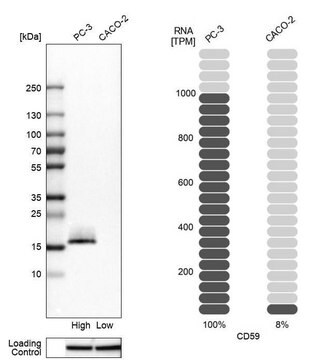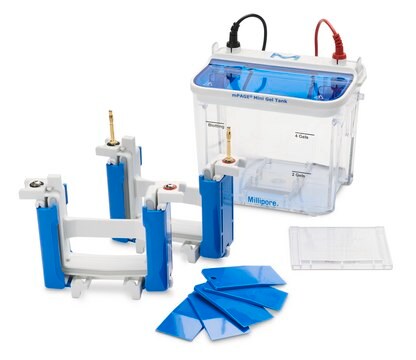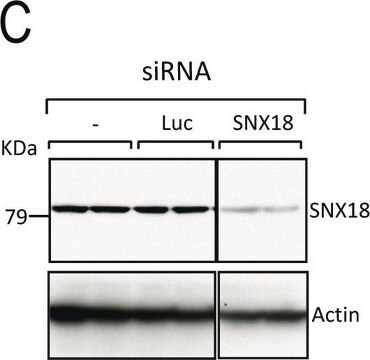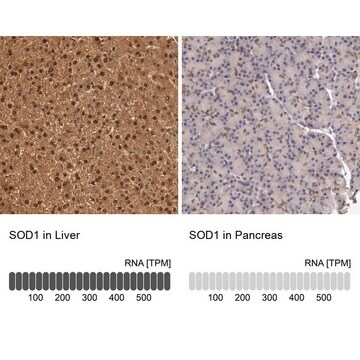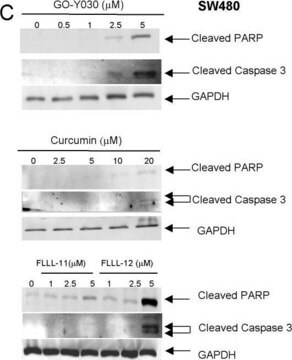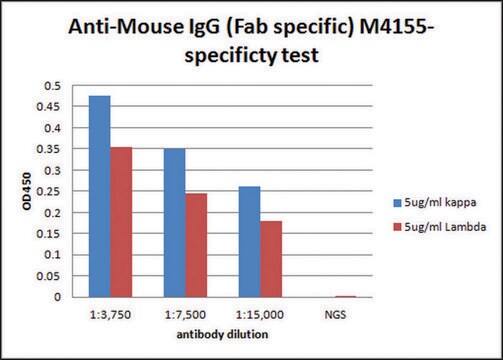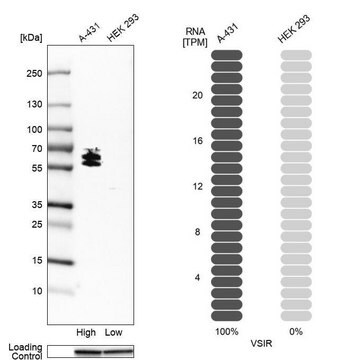HPA034972
Anti-RBM10 antibody produced in rabbit

Prestige Antibodies® Powered by Atlas Antibodies, affinity isolated antibody, buffered aqueous glycerol solution
동의어(들):
Anti-DXS8237E, Anti-GPATC9, Anti-GPATCH9, Anti-KIAA0122, Anti-RNA binding motif protein 10, Anti-ZRANB5
로그인조직 및 계약 가격 보기
모든 사진(7)
About This Item
추천 제품
생물학적 소스
rabbit
결합
unconjugated
항체 형태
affinity isolated antibody
항체 생산 유형
primary antibodies
클론
polyclonal
제품 라인
Prestige Antibodies® Powered by Atlas Antibodies
양식
buffered aqueous glycerol solution
종 반응성
human
향상된 검증
RNAi knockdown
Learn more about Antibody Enhanced Validation
기술
immunoblotting: 0.04-0.4 μg/mL
immunofluorescence: 0.25-2 μg/mL
immunohistochemistry: 1:500-1:1000
면역원 서열
MEYERRGGRGDRTGRYGATDRSQDDGGENRSRDHDYRDMDYRSYPREYGSQEGKHDYDDSSEEQSAEDSYEASPGSETQRR
UniProt 수납 번호
배송 상태
wet ice
저장 온도
−20°C
타겟 번역 후 변형
unmodified
유전자 정보
human ... RBM10(8241)
면역원
RNA binding motif protein 10 recombinant protein epitope signature tag (PrEST)
애플리케이션
All Prestige Antibodies Powered by Atlas Antibodies are developed and validated by the Human Protein Atlas (HPA) project and as a result, are supported by the most extensive characterization in the industry.
The Human Protein Atlas project can be subdivided into three efforts: Human Tissue Atlas, Cancer Atlas, and Human Cell Atlas. The antibodies that have been generated in support of the Tissue and Cancer Atlas projects have been tested by immunohistochemistry against hundreds of normal and disease tissues and through the recent efforts of the Human Cell Atlas project, many have been characterized by immunofluorescence to map the human proteome not only at the tissue level but now at the subcellular level. These images and the collection of this vast data set can be viewed on the Human Protein Atlas (HPA) site by clicking on the Image Gallery link. We also provide Prestige Antibodies® protocols and other useful information.
The Human Protein Atlas project can be subdivided into three efforts: Human Tissue Atlas, Cancer Atlas, and Human Cell Atlas. The antibodies that have been generated in support of the Tissue and Cancer Atlas projects have been tested by immunohistochemistry against hundreds of normal and disease tissues and through the recent efforts of the Human Cell Atlas project, many have been characterized by immunofluorescence to map the human proteome not only at the tissue level but now at the subcellular level. These images and the collection of this vast data set can be viewed on the Human Protein Atlas (HPA) site by clicking on the Image Gallery link. We also provide Prestige Antibodies® protocols and other useful information.
특징 및 장점
Prestige Antibodies® are highly characterized and extensively validated antibodies with the added benefit of all available characterization data for each target being accessible via the Human Protein Atlas portal linked just below the product name at the top of this page. The uniqueness and low cross-reactivity of the Prestige Antibodies® to other proteins are due to a thorough selection of antigen regions, affinity purification, and stringent selection. Prestige antigen controls are available for every corresponding Prestige Antibody and can be found in the linkage section.
Every Prestige Antibody is tested in the following ways:
Every Prestige Antibody is tested in the following ways:
- IHC tissue array of 44 normal human tissues and 20 of the most common cancer type tissues.
- Protein array of 364 human recombinant protein fragments.
결합
Corresponding Antigen APREST78312
물리적 형태
Solution in phosphate-buffered saline, pH 7.2, containing 40% glycerol and 0.02% sodium azide.
법적 정보
Prestige Antibodies is a registered trademark of Merck KGaA, Darmstadt, Germany
면책조항
Unless otherwise stated in our catalog or other company documentation accompanying the product(s), our products are intended for research use only and are not to be used for any other purpose, which includes but is not limited to, unauthorized commercial uses, in vitro diagnostic uses, ex vivo or in vivo therapeutic uses or any type of consumption or application to humans or animals.
적합한 제품을 찾을 수 없으신가요?
당사의 제품 선택기 도구.을(를) 시도해 보세요.
Storage Class Code
10 - Combustible liquids
WGK
WGK 1
가장 최신 버전 중 하나를 선택하세요:
Julie J Loiselle et al.
PloS one, 12(6), e0180258-e0180258 (2017-07-01)
Lung cancers are the leading cause of cancer-related deaths worldwide, with small cell lung cancer (SCLC) being the most aggressive type. At the time of diagnosis, SCLC has usually already metastasized, and an astonishing 95% of patients eventually succumb to
Jiawei Zhao et al.
Scientific reports, 7, 40488-40488 (2017-01-17)
RBM10 is an RNA splicing regulator that is frequently mutated in lung adenocarcinoma (LUAD) and has recently been proposed to be a cancer gene. How RBM10 mutations observed in LUAD affect its normal functions, however, remains largely unknown. Here integrative
Sirui Zhang et al.
EBioMedicine, 61, 103067-103067 (2020-11-02)
RNA splicing defects are emerging molecular hallmarks of cancer. The gene encoding splicing factor RNA binding motif protein 10 (RBM10) has been found frequently mutated in various types of cancer, particularly lung adenocarcinoma (LUAD), but how RBM10 affects cancer pathogenesis
Julie J Loiselle et al.
Journal of cellular biochemistry, 119(5), 3809-3818 (2017-12-24)
RBM10 is an RNA binding motif (RBM) protein expressed in most, if not all, human and animal cells. Interest in RBM10 is rapidly increasing and its clinical importance is highlighted by its identification as the causative agent of TARP syndrome
Yue Sun et al.
Nucleic acids research, 45(14), 8524-8540 (2017-06-07)
Mutations in the spliceosomal RNA binding protein RBM10 cause TARP syndrome and are frequently observed in lung adenocarcinoma (LUAD). We have previously shown that RBM10 enhances exon skipping of its target genes, including its paralog RBM5. Here, we report that
자사의 과학자팀은 생명 과학, 재료 과학, 화학 합성, 크로마토그래피, 분석 및 기타 많은 영역을 포함한 모든 과학 분야에 경험이 있습니다..
고객지원팀으로 연락바랍니다.
